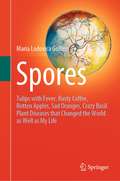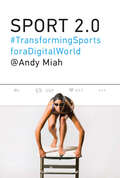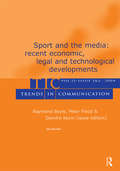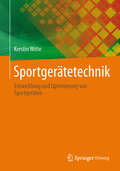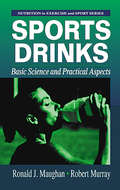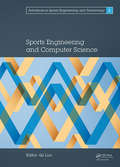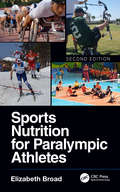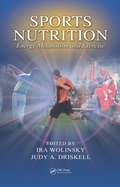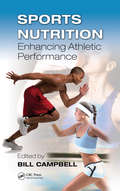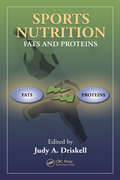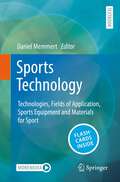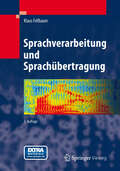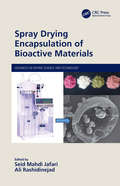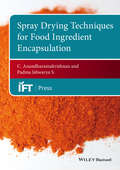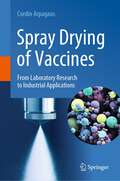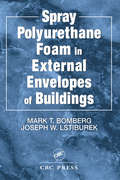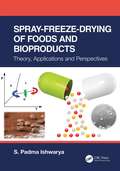- Table View
- List View
Spores: Tulips with Fever, Rusty Coffee, Rotten Apples, Sad Oranges, Crazy Basil. Plant Diseases that Changed the World as Well as My Life
by Maria Lodovica GullinoThis book aims to describe, though in a quite light way, the social role of plant diseases, letting the reader know the topical importance of plant pathology, as well as the role of plant pathologists in our society. Plant diseases caused, in the past, significant economic losses, deaths, famine, wars, and migration. Some of them marked the history of entire countries. One example among many: the potato late blight in Ireland in 1845. Today plant diseases are still the cause of deaths, often silent, in developing countries, and relevant economic losses in the industrialized ones. This book, written with much passion, neither wants to be a plant pathology text. On the contrary, it wants to describe, in simple words, often enriched by the author's personal experience, various plant diseases that, in different times and countries, did cause severe losses and damages. Besides the so-called “historical plant diseases”, in the process of writing this book, she wanted to describe also some diseases that, though not causing famine or billions of losses, because of their peculiarity, might be of interest for the readers. Thus, this book has not been conceived and written for experts, but for a broader audience, of different ages, willing to learn more about plant health and to understand the reasons why so many people in the past and nowadays choose to be plant pathologists. This is because plants produce most of the food that we consume, that we expect to be healthy and safe, and because plants make the world beautiful. The title “Spores” is evocative of the reproduction mean of fungi. Spores are small, light structures, often moving fast. The chapters of this book are short and concise. Just like spores!
Sport 2.0: Transforming Sports for a Digital World (The\mit Press Ser.)
by Andy MiahRamifications of the convergence of sports and digital technology, from athlete and spectator experience to the role of media innovation at the Olympics.Digital technology is changing everything about modern sports. Athletes and coaches rely on digital data to monitor and enhance performance. Officials use tracking systems to augment their judgment in what is an increasingly superhuman field of play. Spectators tune in to live sports through social media, or even through virtual reality. Audiences now act as citizen journalists whose collective shared data expands the places in which we consume sports news. In Sport 2.0, Andy Miah examines the convergence of sports and digital cultures, examining not only how it affects our participation in sport but also how it changes our experience of life online. This convergence redefines how we think of about our bodies, the social function of sports, and the kinds of people who are playing. Miah describes a world in which the rise of competitive computer game playing—e-sports—challenges and invigorates the social mandate. Miah also looks at the Olympic Games as an exemplar of digital innovation in sports, and offers a detailed look at the social media footprint of the 2012 London Games, discussing how organizers, sponsors, media, and activists responded to the world's largest media event.In the end, Miah does not argue that physical activity will cease to be central to sports, or that digital corporeality will replace the nondigital version. Rather, he provides a road map for how sports will become mixed-reality experiences and abandon the duality of physical and digital.
Sport and the Media: Recent Economic, Legal, and Technological Developments:a Special Double Issue of trends in Communication
by Raymond Boyle;Peter Flood;Deirdre KevinSport and the Media examines how reliable sportscasting is in the anchor role, reviews the development of sportscasting and specialized sporting services as a response to audience demand, and questions how well the sporting enthusiast--the fan--is being served by later, unanticipated developments. While sport has had a long symbiotic relationship with communication systems, the advent of a digital media age has intensified that relationship, giving evidence of both continuity and substantial change in this relationship as both media systems and popular culture have entered a new century. Collectively, the articles give an authentic flavor of the issues--real and incipient--surrounding sports broadcasting, the media, and the audience as the next round of media consolidation and investment appears to be starting. In particular, they pose questions as to whether sports as a 'killer application' has actually encountered some natural limit, and whether the audience at-large has been well served within the more recent developments.
Sportgerätetechnik
by Kerstin WitteDas Buch schlägt Lösungskonzepte zur Entwicklung und Optimierung von Sportgeräten und Sportausrüstungen vor. Dabei werden die besonderen physikalischen und biomechanischen Aspekte dieser Produkte berücksichtigt. Auch wird auf die unterschiedlichen Benutzergruppen eingegangen. Durch zahlreiche praktische Beispiele und die Erläuterung des methodischen Vorgehens erhält der Leser Anregungen für neue Produktentwicklungen als auch deren Evaluation im Bereich der Sportartikel. So wird es ihm möglich sein, Lösungen für sein konkretes Problem zu finden.
Sports Analytics: Data-Driven Sports and Decision Intelligence
by Dieu Hack-Polay Ali B. Mahmoud P. Mary Jeyanthi A. MansuraliIn "Sports Analytics: Data-Driven Sports and Decision Intelligence," embark on a journey through the exhilarating world of sports enhanced by the power of data-driven insights. From the nail-biting moments on the field to the strategic decisions behind the scenes, this comprehensive guide unveils the secrets that propel teams to victory and champions to greatness.It explores the cutting-edge techniques and methodologies that revolutionize the way we understand and analyze sports performance. From player evaluations to game strategies, injury prevention to fan engagement, this book equips you with the tools to gain a competitive edge in any sport. Whether you're a coach, player, analyst, or simply a passionate fan, this book will change the way you see the game. This book details how to use analytics and machine learning to highlight key performance indicators (KPIs) of sports for analysis. The authors show how to apply various statistical techniques, machine learning and data mining algorithms for on-field and off-field analysis. They go on to show how analytical algorithms are used in the sports ecosystem to derive solutions for the team and leadership, helping team managers and coaches to monitor games and player information through dashboards. The book then shows how to deploy machine learning algorithms for validating and improving teams and players performance. The book is relevant to professionals and academics working in machine learning and data analysis related to sports.
Sports Concussions: A Complete Guide to Recovery and Management
by Isabelle Gagnon Alain PtitoSport-related concussions have become an increasingly important topic as evidenced by recent media attention. Due in large part to the complex nature of concussive injuries, there is great discrepancy in the effect these injuries have on individual functioning and the type and nature of services that best facilitate recovery. This book is intended as a complete reference guide dealing with sports-related concussions.
Sports Drinks: Basic Science and Practical Aspects
by Ronald J. Maughan Robert MurrayCan sports drinks improve the way you play and exercise? Athletes-both competitive and recreational-turn to the consumption of sports drinks to optimize their performance. A volume in the Nutrition in Exercise and Sports Series, Sports Drinks: Basic Science and Practical Aspects provides a review of current knowledge on issues relating to the formu
Sports Engineering and Computer Science: Proceedings of the International Conference on Sport Science and Computer Science (SSCS 2014), Singapore, 16-17 September 2014 (Advances in Sports Engineering and Technology)
by Qi LuoSports Engineering and Computer Science contains papers presented at the 2014 International Conference on Sport Science and Computer Science (SSCS 2014), held September 16-17, 2014 in Singapore and at the 2014 International Conference on Biomechanics and Sports Engineering (BSE 2014), held October 24-25, 2014, in Riga, Latvia. The contributions hav
Sports Ergonomics: Proceedings of HWWE 2022 (Design Science and Innovation)
by Rauf Iqbal Vivek Khanzode Ajita D. SinghThis book presents select proceedings of the International Conference on Humanizing Work and Work Environment (HWWE-2022) conducted at Punjabi University, Patiala. The conference proceedings examine a range of issues confronted by researchers and practitioners in the field of ergonomics and human factors engineering today. The book showcases latest research on physical ergonomics, workplace design, product design for usability, user interface and experience design, and assessment of cognitive workload, among other topics. The book also discusses various methodological approaches used by researchers and scientists in the field of ergonomics, such as participatory ergonomics, survey research, experimental design, data driven modeling and other recent approaches. This book will be a useful reference for researchers, practitioners, professionals, and consultants in the field of ergonomics, human factors engineering, and worksystem design.
Sports Nutrition Methods (Methods and Protocols in Food Science)
by Ayan Chatterjee Tanmay SarkarThis volume provides comprehensive methods and is a practical guide for sports scientists and nutrition practitioners. Written in the format of the Methods and Protocols in Food Science series, the chapters include an introduction to the respective topic, list necessary materials and reagents, detail well established and validated methods for readily reproducible laboratory protocols and contain notes on how to avoid or solve typical problems. Authoritative and cutting-edge, Sports Nutrition Methods aims to empower readers to precisely identify, assess, and tailor interventions related to body composition and nutritional needs for optimal sports performance.
Sports Nutrition Needs for Child and Adolescent Athletes
by Elizabeth Fox Chad M. KerksickAs the number of child and adolescent athletes continues to increase each year, more children are being exposed to greater training volumes and increasing physical demands-making the need for nutritional and recovery guidance increasingly important. While massive amounts of empirical research are published each year on responses and adaptations to
Sports Nutrition for Paralympic Athletes, Second Edition
by Elizabeth BroadSports participation opportunities for individuals with impairments are increasing. Whether an athlete is beginning a sport or competing on the world stage for a podium finish, nutrition is recognized as being integral to optimizing their health, training capacity, and performance. Some athletes with impairments are physiologically similar to their able-bodied counterparts, whereby the application of sports nutrition principles is straightforward. However, athletes with certain impairments require a very individualized approach when applying these principles in a practical way. Fully updated and expanded, this second edition of Sports Nutrition for Paralympic Athletes is an essential resource for sports nutrition practitioners who work alongside athletes with an impairment, whether that be physical, visual, hearing, or intellectual. In addition to chapters devoted to each impairment type, this book covers specific areas including medical considerations, body composition, supplements, and practical aspects that can be applied across all athletes and sports. Case studies and messages from athletes and world-class coaches enhance the application of theoretical research into practice providing the most relevant sports nutrition advice to Para athletes. Features New chapters on energy availability in Para athletes and cooling and hydration for the Para athlete Concise review of current sports nutrition recommendations for athletes, both during training and in competition Provides practical guidance and examples on how to apply sports nutrition principles to each impairment type Includes real life experiences of Para athletes, elite coaches, and practitioners Encompasses wider topics of assessing body composition, medical considerations, and supplement use specific to Para athletes Features insight and experiences gained by practitioners over the three major Paralympic Games since the first edition Sports nutrition can be the difference between being competitive and making the podium. With the rapidly increasing Paralympic profile, this book is valuable for professionals endeavoring to give their athletes the competitive edge - it challenges, stimulates, and drives future research in this area to continue to improve the delivery of this intrinsic component of athlete preparation.
Sports Nutrition: Energy Metabolism and Exercise (Nutrition in Exercise & Sport)
by Ira Wolinsky Judy A. DriskellExercise by itself tears down the body. To rebuild that body so that it expresses greater strength, endurance, and speed, requires sound nutritional practices based on fact rather than fad. Those practices must also recognize that specific needs vary greatly according to age, gender, and intensity of exercise.Sports Nutrition: Energy Metabo
Sports Nutrition: Enhancing Athletic Performance
by Bill I. CampBellWith the constant flow of information related to sports nutrition coming from scholarly journals, it is difficult to sift through it all and determine what is relevant. Sports Nutrition: Enhancing Athletic Performance helps in this endeavor, with more than 1,000 references from top academic journals, offering critical knowledge concerning nutrient
Sports Nutrition: Fats and Proteins
by Judy A. DriskellIt is well known that fats, proteins, and carbohydrates are all energy-yielding nutrients that influence health and physical performance. Yet many recreational, collegiate, and professional athletes still consume more fats, saturated fats, and cholesterol than is recommended, as well as inappropriate amounts of proteins. What is needed is a nuts an
Sports Nutrition: Vitamins and Trace Elements, Second Edition
by Judy A. Driskell Ira WolinskyIn competitive sports where an extra breath or a millisecond quicker neural response can spell the difference between fame and mediocrity, a number of myths have persisted around the impact of what might be considered megadoses of various vitamins and trace elements. We do know that a growing body of research indicates that work capacity, oxygen co
Sports Technology and Engineering: Proceedings of the 2014 Asia-Pacific Congress on Sports Technology and Engineering (STE 2014), December 8-9, 2014, Singapore (Advances in Sports Engineering and Technology)
by Qi LuoThe 2014 Asia-Pacific Congress on Sports Technology and Engineering (STE 2014) was held in Singapore, December 8-9, 2014. STE2014 was a comprehensive conference focused on various aspects of advances in Sports Technology and Engineering. Topics covered by the contributions to this proceedings volume include but are not limited to Sports Science, Co
Sports Technology: Technologies, Fields of Application, Sports Equipment and Materials for Sport
by Daniel MemmertSports technological tools and innovations are gaining increasing significance in amateur, elite, and health-related sports. Sports technology refers to the application of scientific and technical principles, along with innovative technologies, to enhance athletic performance, increase safety, and consequently optimize the overall sporting experience. This involves the design, development, and utilization of equipment, devices, systems, and software specifically tailored for athletic purposes.This textbook aims to encompass the broad diversity of sports technology by featuring contributions from over 30 authors within their respective specialized fields, summarizing the latest insights concisely. The work is structured into five main sections: Data Acquisition Systems, Sports Equipment and Materials, Diagnostics, Evaluation and Communication, and Selected Fields of Application. Students with a connection to sports science gain a comprehensive understanding of sports technology supported by a carefully designed concept that facilitates easy delivery of learning content. Digital learning cards (SN Flashcards) reinforce the learning effect and ensure optimal exam preparation. For advanced learners, in-depth discussions on topics such as tracking data, digital training assistants, sports floor characteristics, virtual reality in sports, smartphone apps, and diagnostic tools offer additional value.
Sporttechnologie: Technologien, Anwendungsfelder, Sportgeräte und Materialien für den Sport
by Daniel MemmertSporttechnologische Tools und Innovationen erhalten im Breiten-, Leistungs- und Gesundheitssport eine immer größere Bedeutung. Sporttechnologie bezieht sich auf die Anwendung wissenschaftlicher und technischer Prinzipien sowie innovativer Technologien, um sportliche Leistung zu verbessern, die Sicherheit zu erhöhen und somit das gesamte Sporterlebnis zu optimieren. Dabei geht es um das Design, die Entwicklung sowie den Einsatz von Ausrüstung, Geräten, Systemen und Software, speziell für sportliche Zwecke.Dieses Lehrbuch möchte der breiten Vielfalt der Sporttechnologie gerecht werden, indem mehr als 30 Autorinnen und Autoren aus ihrem Spezialgebiet berichten und neuste Erkenntnisse prägnant zusammenfassen. Das Werk gliedert sich in fünf Hauptabschnitte: Daten-Erfassungssysteme, Sportgeräte und Materialien, Diagnostik, Evaluation und Kommunikation sowie Ausgewählte Anwendungsfelder. Studierende mit Bezug zur Sportwissenschaft erhalten einen umfassenden Einblick in die Sporttechnologie, unterstützt durch ein didaktisch ausgefeiltes Konzept, das eine einfache Vermittlung der Lerninhalte ermöglicht. Digitale Lernkarten (SN Flashcards) untermauern den Lerneffekt und gewährleisten eine optimale Prüfungsvorbereitung. Für Fortgeschrittene bietet die vertiefende Diskussion von Themen wie Tracking Daten, digitalen Trainingsassistenten, Sportbodeneigenschaften, virtuelle Realität im Sport, Smartphone Apps und Diagnostik-Tools einen zusätzlichen Mehrwert.
Sprachverarbeitung und Sprachübertragung
by Klaus FellbaumIn dem Standardwerk der Informationsverarbeitung werden nicht nur die elektroakustischen und nachrichtentechnischen Grundlagen dargestellt, auch die Sprache als menschliche Kommunikationsform wird aus linguistischer und physiologischer Perspektive beschrieben. Berücksichtigt wird dabei neben der Theorie stets die Anwendung - auf dem neuesten Stand der Technik. Die 2. Auflage bietet neue Abschnitte zu den Grundzügen der Signalanalyse und zu Sprachdialogsystemen. Audiobeispiele und multimediale Vortragselemente zum Download auf extras.springer.com.
Spray Drying Encapsulation of Bioactive Materials (Advances in Drying Science and Technology)
by Seid Mahdi Jafari Ali RashidinejadEncapsulation of bioactives is a fast-growing approach in the food and pharmaceutical industry. Spray Drying Encapsulation of Bioactive Materials serves as a source of information to offer specialized and in-depth knowledge on the most well-known and used encapsulation technology (i.e., spray drying) and corresponding advances. It describes the efficacy of spray drying in terms of its advantages and challenges for encapsulation of bioactive ingredients. Discusses the potential of this technique to pave the way toward cost-effective, industrially relevant, reproducible, and scalable processes that are critical to the development of delivery systems for bioactive incorporation into innovative functional food products and pharmaceuticals Presents the latest research outcomes related to spray drying technology and the encapsulation of various bioactive materials Covers advances in spray drying technology that may result in a more efficient encapsulation of bioactive ingredients Includes computational fluid dynamics, advanced drying processes, as well as the morphology of the dried particles, drying kinetics analyzers, process controllers and adaptive feedback systems, inline powder analysis technologies, and cleaning-in-place equipment Aimed at food manufacturers, pharmacists, and chemical engineers, this work is of interest to anyone engaged in encapsulation of bioactive ingredients for both nutraceutical and pharmaceutical applications.
Spray Drying Techniques for Food Ingredient Encapsulation
by Padma Ishwarya S. C. AnandharamakrishnanSpray drying is a well-established method for transforming liquid materials into dry powder form. Widely used in the food and pharmaceutical industries, this technology produces high quality powders with low moisture content, resulting in a wide range of shelf stable food and other biologically significant products. Encapsulation technology for bioactive compounds has gained momentum in the last few decades and a series of valuable food compounds, namely flavours, carotenoids and microbial cells have been successfully encapsulated using spray drying. Spray Drying Technique for Food Ingredient Encapsulation provides an insight into the engineering aspects of the spray drying process in relation to the encapsulation of food ingredients, choice of wall materials, and an overview of the various food ingredients encapsulated using spray drying. The book also throws light upon the recent advancements in the field of encapsulation by spray drying, i.e., nanospray dryers for production of nanocapsules and computational fluid dynamics (CFD) modeling. Addressing the basics of the technology and its applications, the book will be a reference for scientists, engineers and product developers in the industry.
Spray Drying of Vaccines: From Laboratory Research to Industrial Applications
by Cordin ArpagausThis book addresses the stabilization of vaccine powders by spray drying and provides an overview of the current state of the art on a laboratory and industrial scale. The book aims to familiarize readers with the advances in vaccine spray drying technology to understand its application potential better. In particular, the book addresses the design of aseptic spray dryers, parameters affecting the spray drying process, sterile powder processing, cleaning procedures, and powder filling. In addition, different drying technologies for the production of dry powder vaccines are compared to discuss the unique capabilities of spray drying as a particle technology for vaccines. Special attention is given to research studies on spray-dried vaccines published over the past 30 years, with key findings from laboratory research to clinical trials. Potential applications of spray-dried vaccines and routes of administration are presented in detail. Finally, an outlook is given on how close the aseptic spray-drying of vaccines is to the market and the challenges that need to be overcome to be commercially successful. The book's target audience is academics, researchers, vaccine developers, industry experts, students, and possibly funders, including government agencies, who are active in the field. In addition, the book is a reference source for those involved in the vaccine formulation and biopharmaceutical processing industry.
Spray Polyurethane Foam in External Envelopes of Buildings
by Mark T. Bomberg Joseph W. LstiburekSpray Polyurethane Foams in External Envelopes of Buildings presents, for the first time, a book focused on both the theoretical and practical design and applications of spray polyurethane foam (SPF) use. To review the moisture performance of SPF, this book focuses on the design of an assembly where moisture is kept from accumulating and causing deterioration (flow through approach). In this approach, Spray Polyurethane Foam presents two unique parts of theory and practice of various SPF products. FROM THE PREFACEPart 1 of this monograph analyzes SPF performance as the material (product). Being field fabricated, installation of SPF products must include a quality assurance program . . . Laboratory evaluation of foams and their coverings, quality management issues, and quantification of the technical support provided to the SPF contractor are also reviewed. Part 2 presents a systems approach to construction. Starting with principles of environmental control of buildings, different aspects of design and performance of roofing and wall systems are reviewed. Details and design recommendations . . . as well as case studies . . . are included.
Spray-Freeze-Drying of Foods and Bioproducts: Theory, Applications and Perspectives
by S. Padma IshwaryaSpray-freeze-drying (SFD) is a synergistic drying technology that imbibes in it the merits of both spray drying and freeze-drying, whilst overcoming the limitations of these predecessor technologies. SFD produces uniquely powdered food and pharmaceutical products with porous microstructure and superior quality attributes. Owing to its atomization step and ultra-low-temperature operation, SFD is a competent drying technique for the production of valuable but sensitive bioactive components. Despite the costs and complexities involved, SFD has a competitive edge over the conventional drying techniques in providing distinctive product attributes. The applications of spray-freeze-drying in the area of food and bioproducts span across the product categories of instant food powders, dry flavors, active pharmaceutical ingredients, poorly water-soluble drugs, probiotics, proteins, enzymes and vaccines. Spray-Freeze-Drying of Foods and Bioproducts: Theory, Applications and Perspectives is the first exclusive title on this interesting drying technique. It provides a comprehensive understanding of the fundamentals of SFD and its food and pharmaceutical applications. The scope of this book, comprising 12 chapters, has been organizedunder four major headings: fundamentals of process-stages, applications with case-studies, recent advancements and the processing bottlenecks and solutions. Key Features Provides examples and case studies of nuances and intricacies associated with each stage of the spray-freeze-drying process Highlights the applications of spray-freeze-drying in the production of food products including soluble coffee, dairy powders, probiotics and flavors Serves as a ready-reckoner of characterization methods for spray-freeze-dried products Contains 200+ illustrations and tabulations The contents of this book are organized to cater to the knowledge needs of students, academicians, researchers and professionals in the food and pharmaceutical industry.
